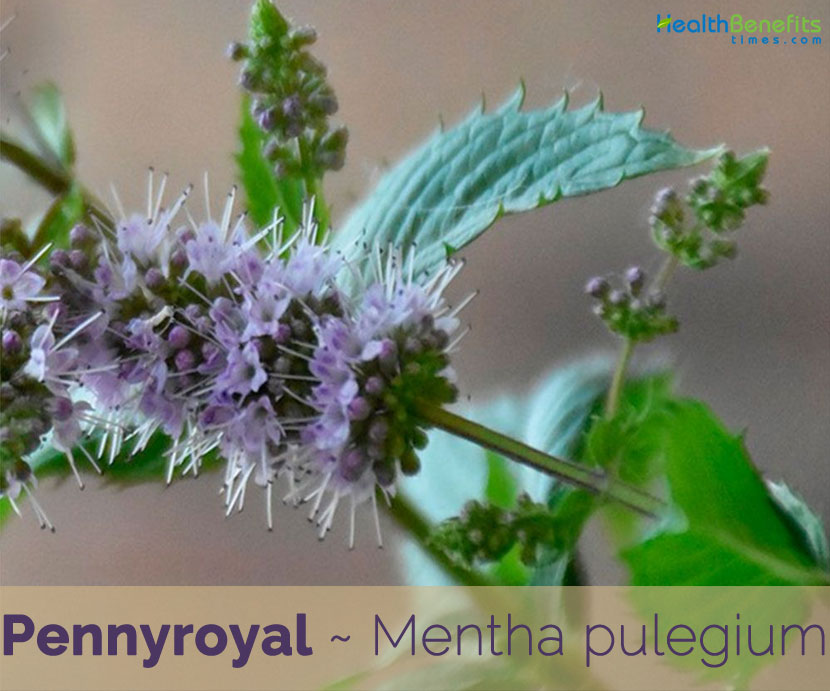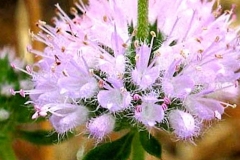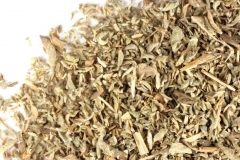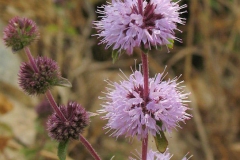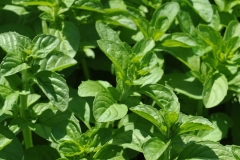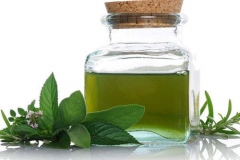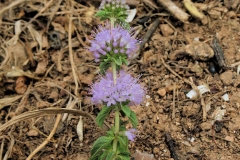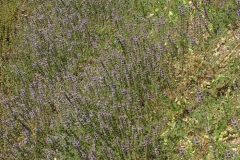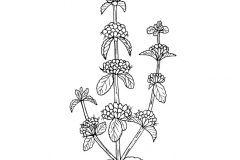Along with other herbs such as oregano, coriander and lovage, Pennyroyal was used by the Romans as a flavoring agent for food. The use of pennyroyal as a culinary herb continued through the middle Ages and was normally used to flavor wine and pudding, however, the use of this plant as a flavoring agent gradually decreased and it is now used for medicinal purposes today. It is a traditional folk remedy, emmenagogue, abortifacient, and culinary herb, but is toxic to the liver and has caused some deaths. Crushed pennyroyal leaves emit a very strong fragrance comparable to spearmint.
Plant Description
Pennyroyal is a low, prostrate, spreading, short-lived, perennial herb that grows about 0.4 meters to 0.6 meter tall. The plant is found growing in grassland, riparian habitats, freshwater wetlands, alluvial plains, valley bottoms, damp shady places, cultivated or waste places near dams or watercourses, flooded or seasonally wet areas, seeps, stream sides, vernal pools, swales, marshes, and ditches. The plant prefers rich, moist soil that is loamy rather than clayey. Stems are hairy when aerial and hairless when submerged, branched, 4-angled and are 10-40 cm high. Crushed Pennyroyal leaves exhibit a very strong fragrance similar to spearmint. European Pennyroyal attracts bees, butterflies and hoverflies. It is cultivated in parts of India for its essential oil.
Leaves
Leaves are about 1-2.5 cm long, smaller further up the stem, lower leaves are petiolate, higher ones are sub-sessile. Leaf is narrowly ovate to elliptic, base tapered to obtuse, tip rounded, and margin entire to finely serrate, lower surface is short-hairy and are hairless when submerged.
Flowers and Fruits
Flowers occur in dense many-flowered clusters in axil of a pair of leaves. Calyx is 10-veined, fused to at least two-third its length. Lower lobes are more pointed than upper lobes, densely covered with spreading hairs. Corolla is 4–6 mm long, usually pale-mauve to lilac. Anthers are exserted. Flowering normally takes place from August to October. Fertile flowers are followed by 0.5-0.75 mm long nutlet that is ovoid to oblong shaped. Fruits are initially green turning to pale brown as they mature.
Health Benefits of Pennyroyal
Pennyroyal has been traditionally used to deal with cold, breathing problems, gall bladder and liver disease, flatulence and stomach pain. It was also used to induce an abortion or to start menstrual periods. Listed below are some of the popular health benefits of using pennyroyal
1. Beneficial for colds or flu
Pennyroyal consists of high menthol content and has been used over the years for its expectorant qualities and its ability to relieve the symptoms of colds or flu. It may help aid breathing and act as a decongestant for the respiratory system and the lungs. According to proponents, the expectorant properties in pennyroyal can help loosen build ups of mucous or phlegm and clear it out of your system.
2. Good for Digestion and stomach Pain
Going back many generations, pennyroyal has been used to improve general digestive health and to treat several common digestive complaints. You can drink small doses of the tea to help treat bloating, gas or stomach pain. The plant also has antispasmodic actions that can help soothe stomach pain or cramp. Many proponents believe that the plant can be consumed in moderation to improve liver function and encourage the production of bile which can help aid digestion.
3. For Muscle and Joint pain
Pennyroyal oil has a warming and numbing quality and is used in massages to help treat sore muscles and joints. Also, because of its depurative qualities, pennyroyal makes for a good treatment for rheumatism and arthritis because it can help eradicate uric acid from the system.
4. For relaxation
Pennyroyal may have mild sedative properties. It was used in the past to combat hysteria and may help to calm the nerves and help people overcome their difficulties with sleeping. However, there is no evidence that pennyroyal works beyond the anecdotal and there are certainly safer and better researched natural options for dealing with stress and sleeplessness.
5. Promote Menstruation
Pennyroyal is well known for its emmenogogue activity. It has been used throughout the years to help stimulate menstruation in women with irregular cycles or in those who do not menstruate at all. There are though many alternative options to encourage menstruation, many of which are far safer than pennyroyal. For this reason, most experts would not recommend using pennyroyal for this purpose.
Traditional uses and benefits of Pennyroyal
- Pennyroyal has been used for centuries in herbal medicine.
- It increases the secretion of digestive juices and relieves flatulence and colic.
- It also powerfully encourages the uterine muscles and encourages menstruation; therefore it should not be recommended for pregnant women since it can procure abortions.
- The herb is antiseptic, antispasmodic, carminative, diaphoretic, emmenogogue, sedative and stimulant.
- Tea made from the leaves has traditionally been used in the treatment of fevers, headaches, minor respiratory infections, digestive disorders, menstrual complaints and various minor ailments.
- It is occasionally used as a treatment for intestinal worms.
- An infusion is used to treat itchiness and formication, inflamed skin disorders such as eczema and rheumatic conditions such as gout.
- Leaves are harvested in the summer as the plant comes into flower and are dried for later use.
- It is also beneficial in cases of spasms, hysteria, flatulence and sickness, being very warming and grateful to the stomach.
- Pennyroyal tea has been used for cold relief, coughs, indigestion, liver and kidney problems.
- Fresh or dried leaves of pennyroyal have also been used when treating influenza, abdominal cramps, to induce sweating, as well as in the treatment of diseases such as smallpox and tuberculosis.
Ayurvedic Health benefits of Pennyroyal
- Body Lice: Prepare a decoction of dried Pennyroyal plant. Wash the affected area with the decoction of 30 g per liter of water. Repeat it 2-3 times a day.
- Small Pox: Prepare an infusion of the Pennyroyal plant. Have three- four teaspoon three to four times a day.
- Rheumatism: To get relief in Rheumatism massage well with Pennyroyal oil.
- Abortifacient: Prepare an infusion of Pennyroyal plant. Have two- four teaspoon two times a day.
- Menses Scanty: Prepare a tea of the herb and drink regularly for 10-15 days.
- Altitude Sickness: Make a decoction of the dried leaves of Pennyroyal. Have a cup once a day.
- Dyspnea: Take few leaves of Lemon Balm. Add Hyssop and Pennyroyal in equal quantity. Prepare a decoction. Have one cup once a day.
Other uses
- An essential oil is obtained from the whole plant, used in soap making and as a cleanser for fabrics.
- Plant has a low spreading habit and can be used as a ground cover, though it is somewhat sparse in the winter and can be invaded by the more aggressive weeds.
- Growing or dried plant repels fleas, ants, moths, mice etc.
- Rats and mice intensely dislike the smell of mint.
- Plant was thus used in homes as a strewing herb and has also been spread in granaries to keep the rodents off the grain.
- Strong infusion applied to the face will keep gnats away in the summer.
- The aromatic leaves are used as an ingredient of pot-pourri.
Precautions
- Pennyroyal should never be used by pregnant women or nursing mothers. It can cause uterine contractions and an increase in menstrual flow and significantly increase the risk of abortion.
- Avoid if patient has fits or seizures and those with liver or kidney disease.
- Oral intake may cause abdominal cramps, fever, nausea, vomiting, confusion, delirium, auditory & visual hallucinations.
- It affects the nervous system as well and may lead to Brain damage.
- Nursing mother should avoid Pennyroyal as it may mix with the breast milk and may cause complications for the new born baby.
- Pennyroyal essential oil has been linked to many severe side effects. These include abdominal pain, nausea, vomiting, swallowing difficulties, fever, chills, muscle spasms, organ failure, increased heart rate, irregular blood pressure changes and coma.
- Larger volumes may result in multi-organ failure that could lead to death.
- Pennyroyal should never be taken by people with kidney or liver diseases. It may irritate the organs and make the disease worse.
- Essential oil in the leaves is antiseptic, though it is toxic in large doses.
References:
https://www.itis.gov/servlet/SingleRpt/SingleRpt?search_topic=TSN&search_value=32270#null
http://www.hear.org/pier/species/mentha_pulegium.htm
https://npgsweb.ars-grin.gov/gringlobal/taxonomydetail.aspx?id=24079
https://pfaf.org/user/Plant.aspx?LatinName=Mentha+pulegium
https://www.cabi.org/isc/datasheet/115572
https://botanical.com/botanical/mgmh/p/pennyr23.html
https://plants.usda.gov/core/profile?symbol=MEPU
http://www.theplantlist.org/tpl/record/kew-125243
https://www.drugs.com/npp/pennyroyal.html
https://gd.eppo.int/taxon/MENPU
https://en.wikipedia.org/wiki/Mentha_pulegium
Comments
| Pennyroyal Quick Facts | |
|---|---|
| Name: | Pennyroyal |
| Scientific Name: | Mentha pulegium |
| Origin | Europe, parts of Asia as well as to the Middle East |
| Colors | Pale brown |
| Shapes | Nutlets, 0.5-0.75 mm long, ovoid to oblong. |
| Taste | Acrid, pungent |
| Health benefits | Beneficial for colds or flu, Digestion and stomach Pain, Muscle and Joint pain, relaxation, Promote Menstruation, fevers, headaches, eczema and rheumatic conditions |
| Name | Pennyroyal |
|---|---|
| Scientific Name | Mentha pulegium |
| Native | Europe, parts of Asia as well as to the Middle East. It was introduced to places in Africa along with Australia and New Zealand |
| Common Names | European pennyroyal, pennyrile, squaw mint, mosquito plant, and pudding grass |
| Name in Other Languages | Afrikaans: Polei Albanian: Mendra e egër, mender, mendër kënete Arabic: faliahih (filyh), falayhuh (filyhh) (فليه (فِليّه)، فليحه (فِليحه), nuenie (naenae), limam ( limam) (نعنع (نَعْنَع)، لمام ( لِمام), naenae ‘uwrubiyun (نعناع أوروبي) Basque: Txortalo Brazil: Hortelã-miúda, menta-miúda, poejo-das-hotas, poejo-real Bulgarian: blatna menta (блатна мента), div dzhodzhen (див джоджен), polski dzhodzhen (полски джоджен), priyatna menta (приятна мента) Catalan: Poliol, Poliol d’aigua, Poniol, brosseta de riu, herba cuquera, herba de la muntanya, herba de mal de ven, herba de menta, herba de Sant Ponç, herba dels estanys, poliol menta, poliol negre, poniol de riera, poniol negre, puliol Chinese: Chun e bo he (唇 萼薄荷 ) Croatian: Mirisna metvica Czech: Polej obecná, máta polej Danish: Polejmynte Dutch: Polei, poleimunt English: European pennyroyal, Pennyroyal, Pudding grass, peppermint, pennyroyal mint Esperanto: Pulegio Finnish: Puolanminttu French: Herbe aux puces, Menthe pouliot, Menthe poulliot, Pouliot, frétillet, herbe de Saint Laurent, Galician: Poexo Georgian: Ombalo (ომბალო) German: Flohkraut, Poleiminze Greek: Ménta Fliskoúni (Μέντα Φλισκούνι) Hebrew: Herbe de Saint Laurent (נענע הכדורים) Hungarian: Csombormenta Irish: Borógach Italian: Menta puleggia, Menta selvatica, Pulegio, Menta pollegio Japanese: Megusa hakka (メグサハッカ), Penirooyaru minto (ペニローヤルミント ) Kurdish: Pûng Lithuanian: Taškuotoji mėta Maltese: Plejju Persian: پونه Polish: Mięta polej Portuguese: Hisopo, Poejo, hortelã-miúda, menta-miúda, poejo-das-hortas, poejo-real, hortelã-dos-açores, hortelã-pimenta-mansa, Romanian: Busuiocul cerbilor Russian: Myata bloshnitsa (Мята блошница), Мята болотная (Мята болотная), mjata blošnica Serbian: metvica (метвица), barska nana (барска нана), drobna mietvica (дробна метвица), konjska nana (коњска нана), poljačak (пољачак), poljačak metvica (пољачак метвица) Slovak: Mäta sivá, polej Slovene: Polaj Spanish: Menta poleo, Poleo, menta, hierba Buena, hierba cuquera, hierba pulguera, menta legítima, menta natural, menta poleo, poleo, poleo común, poleo del campo, poleo manchado, poleo menta, poleo real, poleo Silvestre, tanagel, té del campo, té poleo, Swedish: Polejmynta Turkish: Yarpuz Ukrainian: M’yata bloshina (М’ята блошина) Urdu: پودینہ جبلی Vietnamese: Cây bạc hà hang Welsh: Brymlys |
| Plant Growth Habit | Low, prostrate, and spreading, short-lived, perennial herb |
| Growing Climates | Grassland, riparian habitats, freshwater wetlands, alluvial plains, valley bottoms, damp shady places, cultivated or waste places near dams or watercourses, flooded or seasonally wet areas, seeps, stream sides, vernal pools and swales, marshes, and ditches |
| Soil | Rich, moist soil that is loamy rather than clayey |
| Plant Size | About 0.4 meters to 0.6 meter |
| Stem | Hairy when aerial, hairless when submerged, branched, 4-angled, 10-90 cm high |
| Leaf | Leaves about 1-2.5 cm long, smaller further up the stem, lower leaves petiolate, higher ones subsessile. Leaf narrowly ovate to elliptic, base tapered to obtuse, tip rounded, margin entire to finely serrate, lower surface short-hairy, hairless when submerged |
| Flowering season | August to October |
| Flower | Flowers in dense many-flowered clusters in axil of a pair of leaves. Calyx 10-veined, fused to at least two-third its length; lower lobes more pointed than upper lobes, densely covered with spreading hairs. Corolla 4–6 mm long, usually pale-mauve to lilac. Anthers exserted. |
| Fruit Shape & Size | Nutlets, 0.5-0.75 mm long, ovoid to oblong |
| Fruit Color | Pale brown |
| Seed | |
| Propagation | |
| Flavor/Aroma | Spearmint-like aroma when crushed |
| Taste | Acrid, pungent |
| Plant Parts Used | Whole plant |
| Season | September to October |
| Health Benefits |
|
| Culinary Uses |
|


